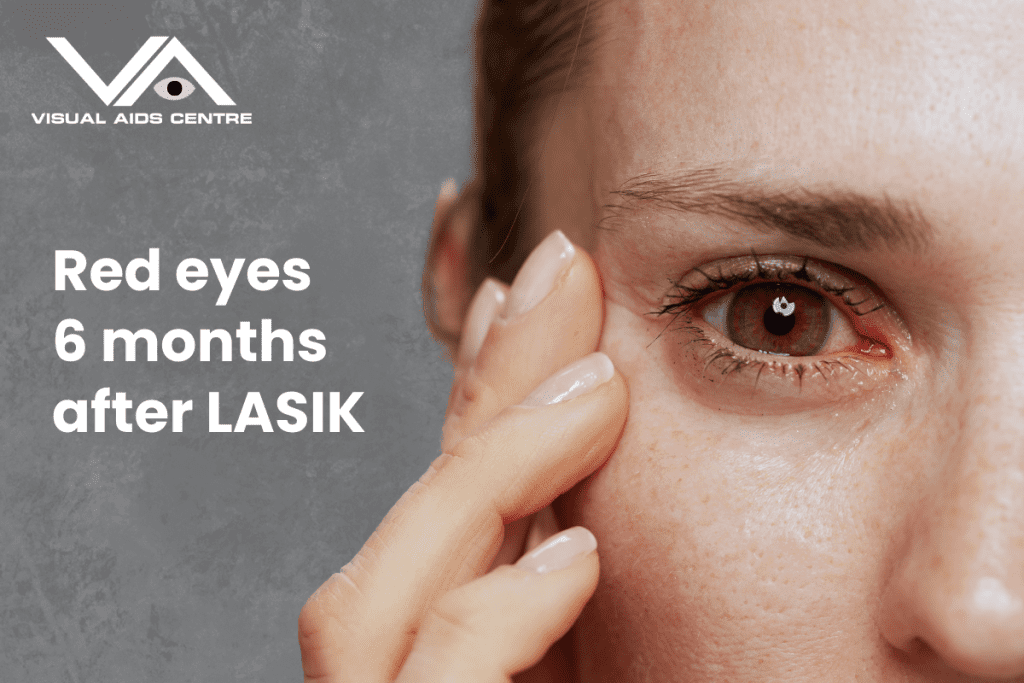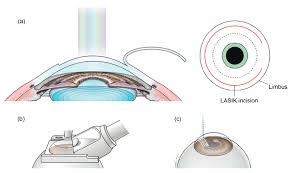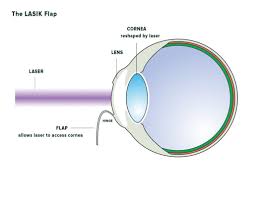Table of Contents
ToggleExperiencing red eyes six months after LASIK surgery is uncommon but not unheard of.
It could indicate lingering dryness, mild irritation, or a separate eye condition that requires attention.

Understanding LASIK Recovery and Redness
LASIK (Laser-Assisted in Situ Keratomileusis) is one of the most popular corrective eye surgeries, offering freedom from glasses or contact lenses. While initial healing is generally swift, with significant improvements noticed within days, complete recovery can extend up to 6 months or more. During this period, complications like dry eyes and redness occasionally persist longer than expected.
Redness in the eyes could be a normal post-surgery symptom or might signal an underlying issue. To address this effectively, it’s crucial first to understand the potential causes and how best to manage them.
What Causes Red Eyes 6 Months Post-LASIK?
1. Eye Dryness
It’s no secret that dry eyes are one of the most common side effects of LASIK. The procedure can temporarily disrupt the nerves responsible for tear regulation, leading to insufficient lubrication. Though tear production usually normalises within 6 months, some individuals might continue experiencing dryness and subsequent redness.
Dry eyes not only cause redness but may also lead to itching, burning, or discomfort. The lack of adequate moisture can make your eyes appear bloodshot due to irritation.
2. Ocular Surface Irritation
If your lifestyle involves long hours of screen time or exposure to environmental factors such as dust, wind, or pollution, this could irritate the ocular surface. Prolonged exposure can exacerbate redness, particularly in eyes that are still healing.
3. Subconjunctival Haemorrhage
Subconjunctival haemorrhage (a small bleed under the clear surface of your eye) can occasionally appear even months after surgery. This condition typically looks more dramatic than it is and may stem from minor trauma, strain during exercise, or even a forceful sneeze.
4. Eye Strain
Digital screens, poor lighting, or inadequate breaks during visual tasks can cause significant strain on the eyes. After LASIK, your eyes may be more susceptible to these stresses, resulting in bloodshot or tired-looking eyes.
5. Flap Complications
While rare, some patients may experience flap-related issues even months after LASIK surgery. Improper flap healing, displacement, or epithelial ingrowth can present symptoms like redness, discomfort, and visual disturbances.
6. Chronic or Delayed Dry Eye Syndrome
For a smaller subset of patients, LASIK can trigger an extended case of dry eye syndrome. Patients prone to severe dryness even before surgery are more likely to face prolonged post-operative symptoms, including redness.
7. Pre-existing or New Overlapping Conditions
Conditions such as blepharitis (inflammation of the eyelids), allergic conjunctivitis, or meibomian gland dysfunction might become more evident post-LASIK. These could account for continued redness six months post-procedure.
8. Refractive Surgery-Induced Stress
Occasionally, the physical stress that corneal tissue endures during LASIK can provoke lingering inflammation, contributing to visible redness even months later.
How Can You Address Redness After 6 Months?
Post-operative symptoms persisting at the 6-month mark deserve attention, even if they pose no immediate threat to your vision. Below are steps to consider for managing red eyes effectively.
1. Consult Your Surgeon or an Ophthalmologist
The first and most essential step is to schedule a follow-up appointment with your ophthalmologist. A professional assessment can identify whether the redness is a minor side effect or indicative of an underlying condition. Timely diagnosis ensures effective management.
2. Lubricate Your Eyes Regularly
Artificial tears or lubricating eye drops are often recommended for managing post-LASIK dryness. Opt for preservative-free formulations as they are gentler on the eyes with frequent use. If standard drops fail to provide relief, consult your doctor about advanced treatments like punctal plugs or serum tears.
3. Avoid Eye Irritants
Minimise exposure to environmental irritants like smoke, dust, or strong winds. If your job or surroundings expose your eyes to these factors regularly, consider wearing protective eyewear.
4. Manage Screen Time
Use the 20-20-20 rule to reduce eye strain during prolonged screen usage. Every 20 minutes, look at something 20 feet away for 20 seconds. Use anti-glare screens or blue light filters to further ease the strain on your eyes.
5. Treat Underlying Conditions
If redness is linked to other conditions like blepharitis or meibomian gland dysfunction, your doctor may suggest treatments such as warm compresses, specialised eyelid scrubs, or omega-3 supplements to improve tear quality and reduce inflammation.
6. Incorporate Rest and Recovery
Healing requires time and care. Avoid habits that might aggravate redness, such as rubbing your eyes, skipping breaks, or engaging in strenuous physical activities without appropriate precautions (e.g., wearing goggles in dusty environments).
Myths Surrounding Post-LASIK Red Eyes
It’s common to feel a bit alarmed by persistent redness, but understanding what’s normal and what’s not can provide peace of mind.
- Myth: Red eyes always indicate a failed LASIK procedure.
Truth: This is not true. Persistent redness could result from unrelated issues like dryness or strain and does not necessarily point to LASIK failure.
- Myth: You’ll never develop dry eye syndrome again after LASIK is healed.
Truth: Even after the recovery window, factors like age, hormonal changes, or medications may influence eye moisture.
Warning Signs That Require Immediate Attention
While moderate redness often resolves with minimal intervention, some cases might warrant urgent medical attention. Contact your doctor immediately if you notice:
- Severe pain or discomfort.
- Sudden changes in vision (e.g., blurry or distorted sight).
- Swelling or discharge from the eye.
- Redness accompanied by light sensitivity or a persistent burning sensation.
These symptoms could indicate more serious conditions such as corneal inflammation, infection, or incomplete flap healing—issues that demand prompt treatment.
How to Prevent Persistent Redness?
Prevention is always better than cure, especially when dealing with eye health. Here are some preventive measures you can incorporate into your routine:
- Adhere to Post-Op Guidelines: Follow your surgeon’s recommendations thoroughly during and after the recovery phase.
- Stay Hydrated: Proper hydration supports tear production, helping to prevent dryness and redness.
- Maintain Good Eye Hygiene: Keep your hands clean and avoid touching your eyes unnecessarily to lower the risk of infections or irritations.
- Invest in Quality Sunglasses: UV rays can prompt irritation, so protect your eyes with sunglasses offering UV400 or higher-level protection.
Wrapping Up
While red eyes 6 months after LASIK surgery are not typical, they are usually manageable with the right interventions. The key is to monitor your symptoms, follow your doctor’s advice, and take proactive measures tailored to your recovery needs.
At its core, LASIK is a life-changing procedure for most patients, and with proper post-operative care, you can fully appreciate its benefits. If you’re still concerned about redness or any other lingering symptoms, do not hesitate to seek professional advice to safeguard your vision and comfort.













